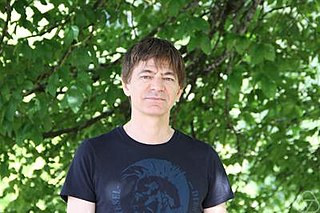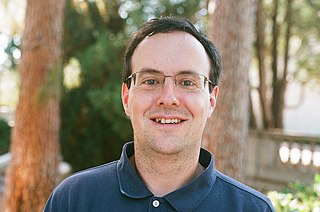In mathematics, the Birch and Swinnerton-Dyer conjecture describes the set of rational solutions to equations defining an elliptic curve. It is an open problem in the field of number theory and is widely recognized as one of the most challenging mathematical problems. It is named after mathematicians Bryan John Birch and Peter Swinnerton-Dyer, who developed the conjecture during the first half of the 1960s with the help of machine computation. As of 2024, only special cases of the conjecture have been proven.
In mathematics, the Sato–Tate conjecture is a statistical statement about the family of elliptic curves Ep obtained from an elliptic curve E over the rational numbers by reduction modulo almost all prime numbers p. Mikio Sato and John Tate independently posed the conjecture around 1960.

Manjul Bhargava is a Canadian-American mathematician. He is the Brandon Fradd, Class of 1983, Professor of Mathematics at Princeton University, the Stieltjes Professor of Number Theory at Leiden University, and also holds Adjunct Professorships at the Tata Institute of Fundamental Research, the Indian Institute of Technology Bombay, and the University of Hyderabad. He is known primarily for his contributions to number theory.
In mathematics, specifically the area of algebraic number theory, a cubic field is an algebraic number field of degree three.
William Philip Minicozzi II is an American mathematician. He was born in Bryn Mawr, Pennsylvania, in 1967.
Lawrence David Guth is a professor of mathematics at the Massachusetts Institute of Technology.
Alex Eskin is an American mathematician. He is the Arthur Holly Compton Distinguished Service Professor in the Department of Mathematics at the University of Chicago. His research focuses on rational billiards and geometric group theory.

James Alexander Maynard is an English mathematician working in analytic number theory and in particular the theory of prime numbers. In 2017, he was appointed Research Professor at Oxford. Maynard is a fellow of St John's College, Oxford. He was awarded the Fields Medal in 2022 and the New Horizons in Mathematics Prize in 2023.

Alexander Nikolaevich Varchenko is a Soviet and Russian mathematician working in geometry, topology, combinatorics and mathematical physics.
Lawrence Clinton Washington is an American mathematician at the University of Maryland who specializes in number theory.
In mathematics, the rank of an elliptic curve is the rational Mordell–Weil rank of an elliptic curve defined over the field of rational numbers or more generally a number field K. Mordell's theorem says the group of rational points on an elliptic curve has a finite basis. This means that for any elliptic curve there is a finite subset of the rational points on the curve, from which all further rational points may be generated. If the number of rational points on a curve is infinite then some point in a finite basis must have infinite order. The number of independent basis points with infinite order is the rank of the curve.
Eleny-Nicoleta Ionel is a Romanian mathematician whose research concerns symplectic geometry, including the study of the Gromov–Witten invariants and Gopakumar–Vafa invariant. Among her most significant results are the construction of relative Gromov-Witten invariants of symplectic manifolds, and the proof of the vanishing in codimension at least g of the tautological ring of the moduli space of genus-g curves.
Vincent Pilloni is a French mathematician, specializing in arithmetic geometry and the Langlands program.
Mihnea Popa is a Romanian-American mathematician at Harvard University, specializing in algebraic geometry. He is known for his work on complex birational geometry, Hodge theory, abelian varieties, and vector bundles.

Jennifer Shyamala Sayaka Balakrishnan is an American mathematician known for leading a team that solved the problem of the "cursed curve", a Diophantine equation that was known for being "famously difficult". More generally, Balakrishnan specializes in algorithmic number theory and arithmetic geometry. She is the Clare Boothe Luce Associate Professor at Boston University.
Christopher McLean Skinner is an American mathematician and professor at Princeton University. He works in algebraic number theory and arithmetic aspects of the Langlands program.

Eric Jean-Paul Urban is a professor of mathematics at Columbia University working in number theory and automorphic forms, particularly Iwasawa theory.
Samit Dasgupta is a professor of mathematics at Duke University working in algebraic number theory.

Denis Auroux is a French mathematician working in geometry and topology.







